It was “two for the price of one” at the LRS meeting on 10th April 2013. Brian Flynn GM8BJF and John Cooke GM8OTI described their recent microwave construction projects.
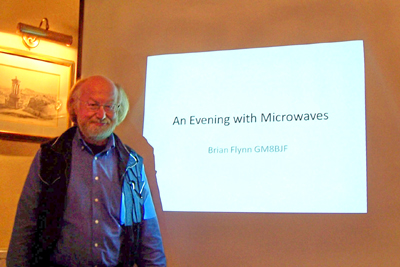
Brian Flynn GM8BJF
Brian GM8BJF started by talking about “getting going on 6cm” He is already active on 3cm (10GHz) and 24GHz. There is no activity in Scotland on any higher bands, so he decided to go down one! The 6cm band is a narrow allocation of 5760 – 5762MHz. He bought a PCB and built a transverter to a design by W1GHZ (cute callsign)! This employs pipe-cap filters which he described. A hybrid power splitter to RX and TX gave 10mW of Tx power. He added two preamp stages. Output is on 144-146 MHz. Several other things were needed to complete the unit – power amplifier, preamp and not least shower-proofing as the unit has to be operated out in the open beside the antenna dish! For the Local Oscillator he used a microwave brick PLL (ex-telecoms). This has a transistorized cavity oscillator whose output is digitally sampled and compared with a crystal oscillator to provide a comb spectrum at 1.7GHz in the brick. The complete unit, including a GaAsFET PA, is built into a box and draws 13A current at 12V. He plans to try this out during the Microwave Contest in May.
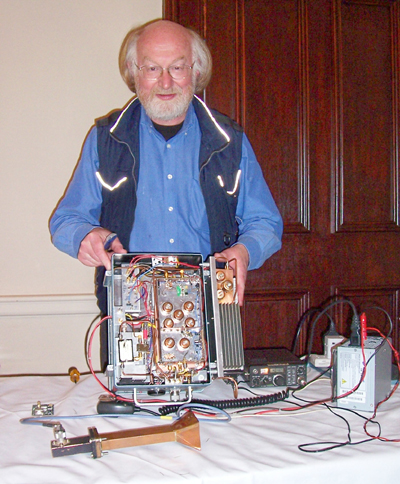
Brian shows his complete 6cm transverter, with the waveguide feed horn in front.
A weak signal source is very useful in lining up equipment when there are no beacons audible. Brian’s 5760MHz source uses a clock oscillator (TCXO) at 12.8MHz, an HC CMOS inverter, giving a 5V square-wave to an ex SAT-TV LNB Schottky diode. All this is easier than on 3cm: 6cm is a “coax band” rather than a “waveguide band”!
Brian then talked about PLL (phase-locked-loop) oscillators as an alternative to oscillator-multiplier chains for the “middle” microwave bands. In addition to 5760 MHz (6cm) he would like to get on 2304 MHz(13cm) and 3456MHz (9cm). Brick oscillators are large and difficult for these bands so he decided to look for a more modern approach. Integrated circuits are available from several manufacturers (Analog Devices, TI / formerly National Semiconductor, and Linear Technology, which work into the microwave bands, some up to 10GHz. Some devices even integrate the VCO on the silicon although they are noisy. Brian is planning a generic circuit board which will work with all these chips. Among the choices are the Analog Devices ADF411x series, which go up to 3GHz. These are available in TSSOP16 SMD packages which are more manageable for home DIY soldering! The implementation of the circuit requires a VCO, voltage regulator, a PIC to hold the frequency programming, and a buffer amplifier. The actual circuit requires a CAD (computer-aided-design) circuit board as the dimensions are very small. Programs are available including demo or “lite” versions for amateur work. These can be purchased at reasonable cost from prototype service companies such as Jackaltac in Ireland.
It is hoped to provide a link to Brian’s presentation as a PDF file shortly.
*************************
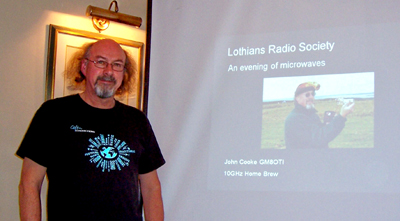
John Cooke GM8OTI
The second talk was by John Cooke GM8OTI who described his 10GHz (3cm) project which had the objective of being built “as simply and cheaply as possible”, and also lightweight (including batteries) as it would be used principally for portable operation. In 1980 he had bought a Gunn diode from J Birkett (still trading in Lincoln!), some waveguide and a few flanges but never did anything with them at the time. Last year he finally used these to build a Gunn oscillator on waveguide, and also built a waveguide detector and wavemeter from components found at the Norbreck rally.
A Gunn oscillator is not really stable enough for modern narrow band communication. The next signal source tried was the local oscillator of an LNB (low noise block) which after modification provided 30-50mW of output power via an SMA connector. This is a useful 10GHz source, but again not really stable enough for narrow band work.
A PLL (phase-locked loop) local oscillator source at 1104MHz was built using a design used previously for 2.3GHz (13cm). After tripling to 3312MHZ and tripling again to 9936MHz this local oscillator gives an IF output at 432MHz (for 10368MHz RF). The multiplier board was built from scratch using pipe-cap filters similarly to what Brian GM8BJF described.
A test signal source was built similarly to 432MHz and 1296MHz units using a block crystal oscillator.
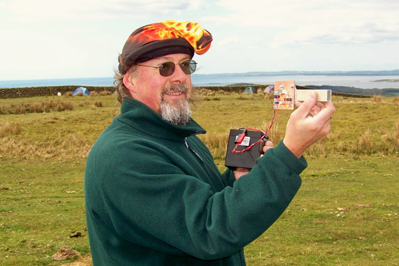
John (in his natty headgear) shows his 3cm weak-signal source at Gatehouse of Fleet.
After problems with the original system stability, a new 2484MHz local oscillator source as built to be multiplied x4 to provide the required 9936MHz to provide the 432MHz IF output . Initially this proved to be noisy, but this was due to the PLL control loop being set up incorrectly and once fixed, this new local oscillator worked very well indeed. It is amplified using a NE32584 amplifier cut from a surplus board bought from Franco Rota (RF Elletronica).
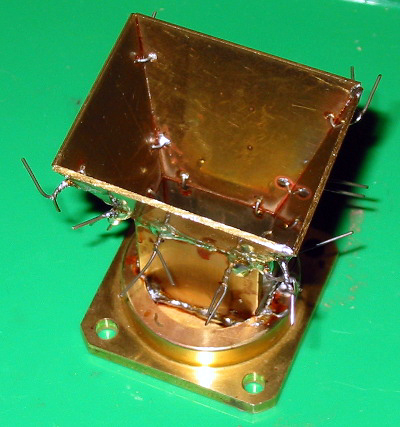
John used a neat way of constructing waveguide and horn items – “stitch & glue”.
The separate parts are stitched together with fine wire and the assembly is then soldered together.
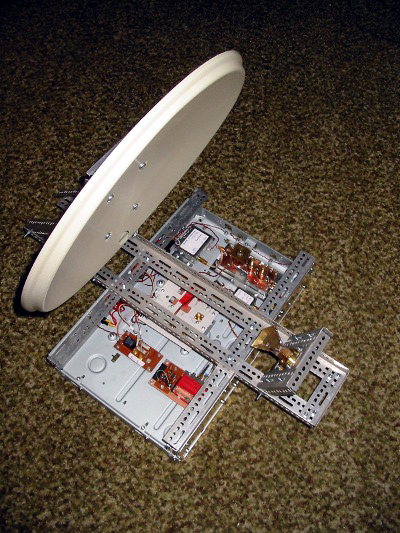
The complete station consists of the local oscillator, Rx and Tx boards fitted inside a former DVD/VCR cabinet. The dish and feed is mounted on an aluminium Dexion assembly. (Pic).
John described a number of tests made with the equipment from portable sites, running 0.7mW (as measured at the Scottish Microwave Round Table in Burntisland):
1. Cairnpapple Hill in West Lothian to Alan GM0USI (running 9W to a 1m dish!) in Kilsyth Hills at 25km. Very strong signals both ways!
2. A high coastal location near Kirkcudbright to G4CBW in Stoke-on-Trent at 223km. John could hear him, but not vice-versa.
3. Cairnpapple Hill To GM0USI above Paisley (the “car park in the sky”) at 54km – not line of sight but still OK.
4. The hills above Gifford to GM0USI in Kilsyth Hills at 87km – another line of sight path, signals still very strong.
Some experiments have been made with a GW4DGU design filter but these are not yet finished. Another amplifier was built using two NE32584 devices from the Franco Rota surplus board, together with another a pipe-cap filter, giving 30-35mW output. This is giving greatly improved results:
5. Blackpool (Norbreck Rally) to GM0USI on Mull of Galloway – much stronger with the higher power. This is a sea path of 148km, not line of sight (being about 400m below the sea horizon!).
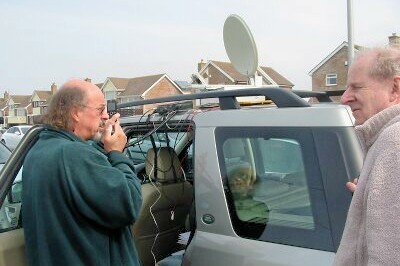
John GM8OTI in Blackpool making contact with Alan GM0USI on the Mull of Galloway, watched by Mike GM4IGS.
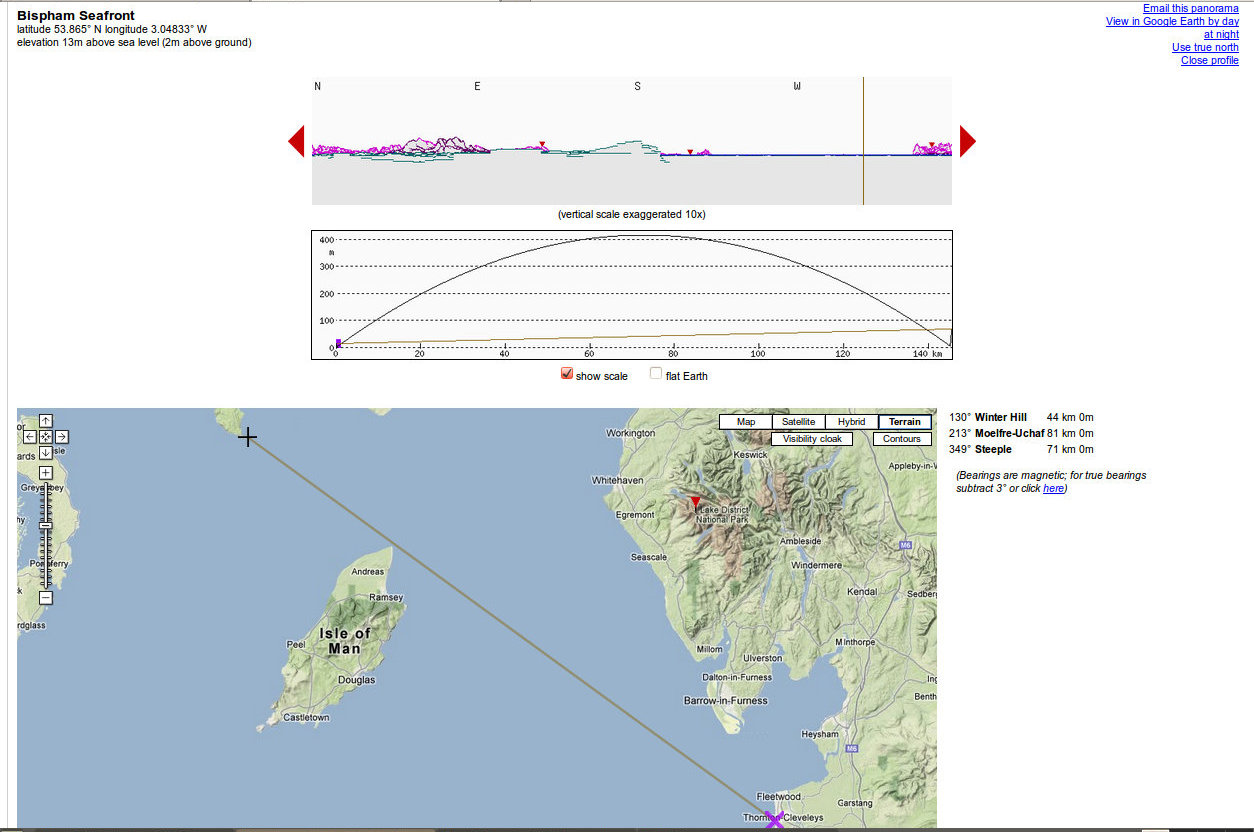
Map and profile of the 148km path from GM8OTI in Blackpool to GM0USI on the Mull of Galloway
Panorama and profile via “Hey What’s That” at http://www.heywhatsthat.com/
John provided these links to his 3cm project (with many photos) on his website:
http://www.marwynandjohn.org.uk/GM8OTI/proj3cmstartup/proj3cmstartup.html
http://www.marwynandjohn.org.uk/GM8OTI/homebrew.html
